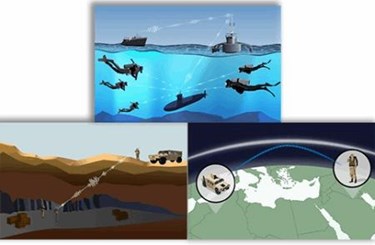Underwater/Underground Radio Communication With Backpack Antennas
By Jof Enriquez,
Follow me on Twitter @jofenriq

Malibu-based HRL Laboratories has received funding from the Defense Advanced Research Projects Agency (DARPA) to develop backpack-based antennas transmitting ultra-low frequency (ULF) signals that can penetrate some distance into media like soil, rock, water, and radio-denied environments.
Typically, radio frequency signals operating in the billions of hertz – gigahertz frequencies are poorly transmitted inside radio-dead zones like bunkers, caves, and tunnels.
To tackle the problem, DARPA's new program, A Mechanically Based Antenna (AMEBA), is experimenting with little-exploited ultra-low-frequency (ULF) electromagnetic waves, transmitting at less than a thousand hertz to send short encoded messages, which could be useful in life-and-death situations.
“For those people in mine disasters, or in buildings collapsed after earthquakes, a portable low-frequency beacon could also make a dramatic difference in search and rescue,” said Walter Wall, project co-lead from HRL’s Advanced Electromagnetics Laboratory.
Other scientists working on similar solutions have used mechanically rotating magnets to mimic a traditional antenna, an apparatus that attains an oscillating magnetic moment by oscillating large amounts of electrical current.
“Our approach is different because, instead of physically spinning a magnet, our device is magnetoelastic, meaning the magnetic field oscillates within the material in response to acoustic stress waves, created through structural vibrations,” said Geoff McKnight, co-lead researcher on the project from HRL’s Sensors and Materials Laboratory.
By vibrating this magnetoelastic material, elongating and compressing, the magnetic field oscillates within the antenna without physically spinning it. This mechanism can be used to control the magnetism and to modulate the signal frequency. HRL scientists say they have devised a technique to rapidly modulate the transmitter frequency with relatively little electrical power.
“This is a pretty exotic project for us,” Wall said. “When you consider that most wireless devices operate at a billion cycles per second, this system will work at a thousand cycles per second. It is a part of the spectrum most people don’t think about much, but it is pushing HRL research in completely new directions, which is a nice thing as well.”
That research includes what DARPA requires out of the AMEBA program – innovations in chemistry and materials (new magnets and electrets), design (shapes and packing geometries of these materials), and mechanical engineering (means of mechanically moving the magnets and electrets to generate the RF signals).
DARPA intends to produce transmitters that are small, light, and power efficient to be carried by individual warfighters in their backpacks. HRL’s antennas use resonant acoustic waves, which travel about million times slower than radio waves, to dramatically shrink the antenna size, weight, and power.
“Mobile low-frequency communication has been such a hard technological problem, especially for long-distance linkages, that we have seen little progress in many years,” said Troy Olsson, AMEBA program manager at DARPA. “With AMEBA, we expect to change that. And if we do catalyze the innovations we have in mind, we should be able to give our warfighters extremely valuable mission-expanding channels of communications that no one has had before.”
